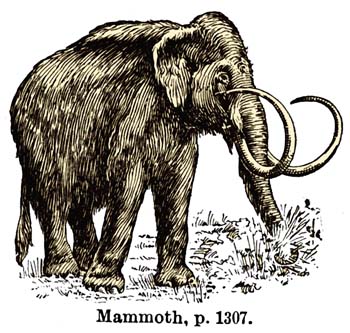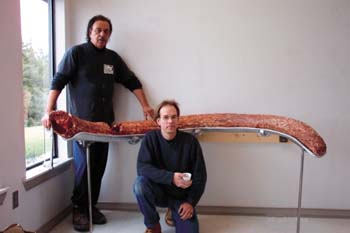 What else they caught that day — if anything — remains undocumented, but one thing is certain: A few fishermen made one heck of a catch at Oklahoma’s Foss Reservoir in late 2001 when they spotted what turned out to be a very, very old mammoth tusk.
What else they caught that day — if anything — remains undocumented, but one thing is certain: A few fishermen made one heck of a catch at Oklahoma’s Foss Reservoir in late 2001 when they spotted what turned out to be a very, very old mammoth tusk.
Because of high water levels, one end of the tusk eroded out near the base of a high bank along the shore of Foss Reservoir, notes Bob Blasing ’86, an archaeologist with the Oklahoma-Texas Field Office of the Bureau of Reclamation.
Discovery of the tusk was only the beginning of an excavation and preservation process that took nearly two years and involved many helping hands from Wichita State.
“We have a cooperative agreement with WSU,” Blasing explains. “The university helps us manage, recover, protect and document such finds, because one of our goals is to provide education to the local public about environmental resources. And we also want to stress to the public that it’s very important to report such finds.” As the bureau’s area archaeologist, Blasing took responsibility for protecting the tusk from the elements — as well as from curious onlookers — until it could be excavated and relocated.
“I called Dr. (Don) Blakeslee in the anthropology department; he’s our main contact at WSU,” he says. “Since he was very busy at the time, he suggested that Jim Dougherty might be interested and want to take over the excavation process.”
A graduate student in anthropology at the time, who has since received his master’s degree, Dougherty ’69/79/03 became the principal investigator and led the excavation, which took place over the course of two days, May 14-15, 2002.
A crew from the University of Oklahoma collected soil samples near the tusk so carbon 14 tests could be conducted, which would help determine the age of the tusk. In addition to the tusk itself, of particular interest was a small bone flake Blasing had found near the site. The bone flake, Dougherty explains, hinted at human occupation in association with the tusk, suggesting that long-ago people living in the area had created tools from tusk bone. “That,” he adds, “ultimately would determine whether the task at hand was an archaeological or a paleontological project.”
Soon after Dougherty and his excavation team of WSU students arrived on site, a 5-foot-long bull snake had to be removed from its hole underneath the tusk. Excavators then divided the site into three sections, each measuring about one meter square, and began uncovering the tusk, most of which was buried about 14 feet below the surface. When the mammoth tusk was fully exposed, its length was 8 feet, 10 inches.
The next step in the process was to encase the tusk in spray foam, to protect it on its journey to Wichita State where it would be restored and prepared for display. Once transported safely to campus in the back of Dougherty’s truck, the tusk was housed in a WSU archaeological laboratory until August 2003.
“We awaited word on the Oklahoma survey on the carbon 14 tests,” says Dougherty. The radiocarbon dating done at ou indicated that the tusk was deposited and buried sometime around 19,000 years ago. This age of deposit meant that the bone flake Blasing found had probably been washed into the area from a nearby, and far more recent, bison bone site. “Current theories,” Dougherty explains, “suggest that humans were not in the area before 15,000 BP. So the project became a paleontological one, which means we received less federal funding, but on the upswing, we had more latitude as far as what we could do with the tusk. We didn’t have to go into as much scientific inventory.”

worked with fellow WSU graduates Jim Dougherty ’69/79/03
and Bob Blasing ’86, both archaeologists, and artist Deborah
Dimmick ’81/85 on Oklahoma’s Foss Reservoir mammoth
tusk project.
Dougherty worked extensively on the tusk, hardening it, gluing minor cracks and pinning major ones so that WSU art technicians Jim Brewer ’78 and Randy Julian ’87 could go into action.
Brewer and Julian’s objective was the creation of a display mount for the tusk, which was to be returned to Foss Reservoir for public display in a new interpretive center located about 90 miles west of Oklahoma City.
The two technicians approached the task with specialized skills — and a bit of humor. “At our ages,” says Brewer, laughing, “you don’t back away from a challenge. You can’t say, ‘Nope. I don’t know how.’”
Since the tusk itself was too fragile to use during the fabrication of the mount, Brewer and Julian first “pulled a plaster mold from the original tusk,” Brewer explains. “Then we cast an exact replica of the original and took it to the studio. We used the replica to fabricate the patterns for the tray and mounting supports that would later hold the original. We wanted to devise a mount that wouldn’t detract from the tusk itself. You don’t want something that’s crude and draws attention away from something so magnificent.”
“Exactly,” adds Julian, who puts a twist on an old real estate motto: “It’s all about presentation, presentation, presentation.”
The painstaking work — from excavation through installation — has been worth it. “The display at the reservoir’s interpretive center is quite a hit,” Dougherty reports. Display highlights include the mounted tusk, photographs of the excavation, four explanatory narratives written by Dougherty and a striking wall painting that artist Deborah Dimmick ’81/85 created of what the mammoth may have looked like in life. The result is a rare glimpse into the distant past.





